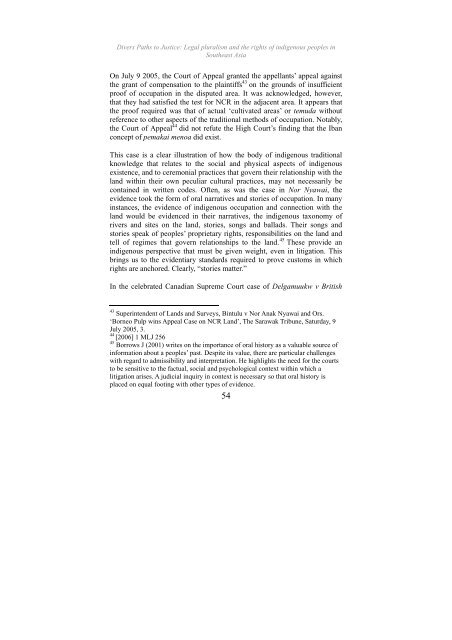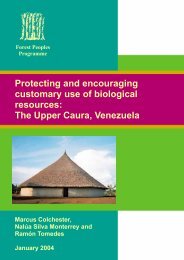Divers Paths to Justice - English - Forest Peoples Programme
Divers Paths to Justice - English - Forest Peoples Programme
Divers Paths to Justice - English - Forest Peoples Programme
You also want an ePaper? Increase the reach of your titles
YUMPU automatically turns print PDFs into web optimized ePapers that Google loves.
<strong>Divers</strong> <strong>Paths</strong> <strong>to</strong> <strong>Justice</strong>: Legal pluralism and the rights of indigenous peoples inSoutheast AsiaOn July 9 2005, the Court of Appeal granted the appellants’ appeal againstthe grant of compensation <strong>to</strong> the plaintiffs 43 on the grounds of insufficientproof of occupation in the disputed area. It was acknowledged, however,that they had satisfied the test for NCR in the adjacent area. It appears thatthe proof required was that of actual ‘cultivated areas’ or temuda withoutreference <strong>to</strong> other aspects of the traditional methods of occupation. Notably,the Court of Appeal 44 did not refute the High Court’s finding that the Ibanconcept of pemakai menoa did exist.This case is a clear illustration of how the body of indigenous traditionalknowledge that relates <strong>to</strong> the social and physical aspects of indigenousexistence, and <strong>to</strong> ceremonial practices that govern their relationship with theland within their own peculiar cultural practices, may not necessarily becontained in written codes. Often, as was the case in Nor Nyawai, theevidence <strong>to</strong>ok the form of oral narratives and s<strong>to</strong>ries of occupation. In manyinstances, the evidence of indigenous occupation and connection with theland would be evidenced in their narratives, the indigenous taxonomy ofrivers and sites on the land, s<strong>to</strong>ries, songs and ballads. Their songs ands<strong>to</strong>ries speak of peoples’ proprietary rights, responsibilities on the land andtell of regimes that govern relationships <strong>to</strong> the land. 45 These provide anindigenous perspective that must be given weight, even in litigation. Thisbrings us <strong>to</strong> the evidentiary standards required <strong>to</strong> prove cus<strong>to</strong>ms in whichrights are anchored. Clearly, “s<strong>to</strong>ries matter.”In the celebrated Canadian Supreme Court case of Delgamuukw v British43 Superintendent of Lands and Surveys, Bintulu v Nor Anak Nyawai and Ors.‘Borneo Pulp wins Appeal Case on NCR Land’, The Sarawak Tribune, Saturday, 9July 2005, 3.44[2006] 1 MLJ 25645 Borrows J (2001) writes on the importance of oral his<strong>to</strong>ry as a valuable source ofinformation about a peoples’ past. Despite its value, there are particular challengeswith regard <strong>to</strong> admissibility and interpretation. He highlights the need for the courts<strong>to</strong> be sensitive <strong>to</strong> the factual, social and psychological context within which alitigation arises. A judicial inquiry in context is necessary so that oral his<strong>to</strong>ry isplaced on equal footing with other types of evidence.54
















